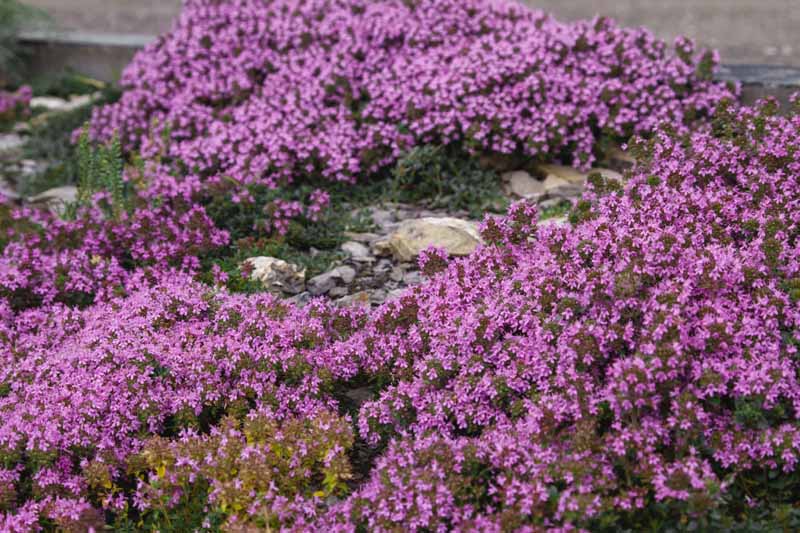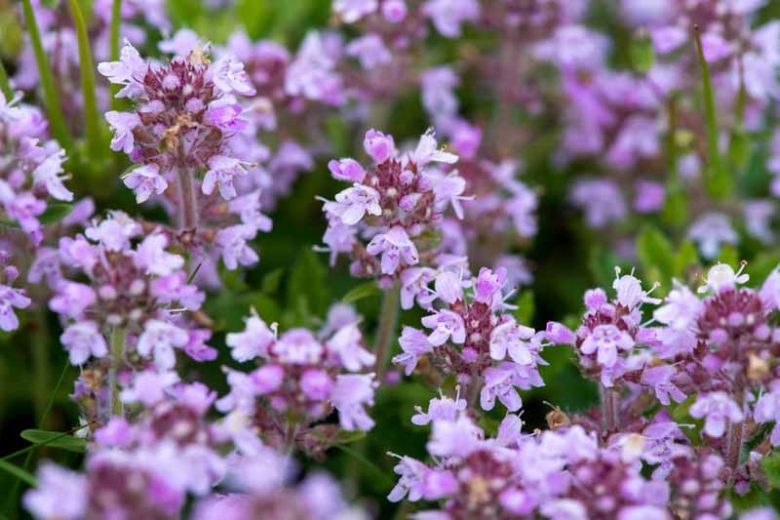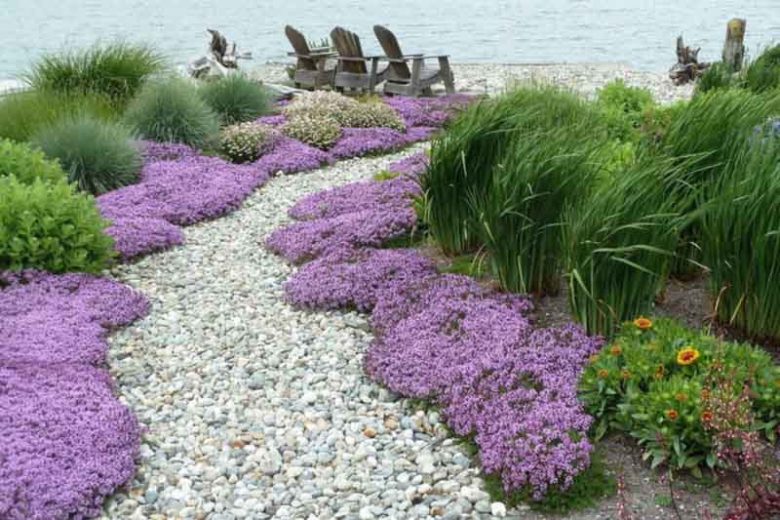Red creeping thyme is a versatile and visually stunning plant that can create an eye-catching carpet of color in any garden. With its lush foliage and vibrant red blooms, this hardy ground cover adds beauty and vibrancy wherever it is planted. In this article, we will explore the many merits of red creeping thyme and provide tips for growing and caring for this delightful garden plant.
Table of Contents
What is the Red Creeping Thyme?
Red creeping thyme (Thymus Serpyllum Coccineas) is a low-growing, spreading perennial herb plant that produces a dense mat of green foliage and striking red flowers. True to its name, this hardy thyme spreads readily to form a lush, carpet-like ground cover. The small oval leaves remain evergreen in mild climates, providing year-round interest and texture.
Each tiny leaf is aromatic when crushed. From early to mid summer, red creeping thyme erupts in a profusion of bright magenta-red blooms on short flower stalks. These colorful blossoms last for weeks and attract pollinators such as bees and butterflies.

Also Know About: Herbal Gardening For Beginners
Growing Red Creeping Thyme
Red creeping thyme grows in a sunny location with well-drained soil. Prior to planting, prepare the soil by mixing in organic matter like compost to improve drainage. Space plants 10-12 inches apart and set them at the same depth they were growing in their nursery pots. Once established, herbaceous perennial plant requires minimal care. It is quite drought tolerant but produces best foliage and flower color with moderate, consistent moisture.
Apply a thin layer of mulch around plants to help retain soil moisture and reduce weeds. Prune lightly after flowering to promote a compact, dense growth habit. Propagate by stem cuttings or division in early spring or fall. With proper care, red creeping thyme will spread to form a lush carpet over time, blanketing the garden area in verdant foliage and vibrant red blooms.
Benefits of Red Creeping Thyme
Incorporating herbaceous perennial plant offers numerous benefits for any garden space. As a spreading ground cover, it works to suppress weeds and prevent soil erosion. The dense foliage forms a living mulch that helps retain soil moisture as it blocks sunlight from reaching weeds. Red creeping thyme has an appealing fragrance and attracts many pollinators, like bees, butterflies, and hummingbirds. The edible leaves and flowers can also be used for culinary purposes. Overall, this herbaceous plant is a very useful and versatile perennial plant.
Using Red Creeping Thyme in Garden Design
The low, spreading habit of red creeping thyme makes it a perfect choice for many garden applications. It can be used as a ground cover in rock gardens, between stepping stones, or along garden pathways. Red creeping thyme is ideal for cascading over walls and containers, providing visual interest and color.
It can also be incorporated into turfgrass alternatives and drought-tolerant lawns. Contrasted with green foliage or gray rocks, the vibrant red blooms of creeping thyme create eye-catching displays. Whether used as an accent, edging, or sweeping ground cover, this herbaceous plant is a great way to add vibrant color, texture, and visual appeal to gardens.

Also Know About: 10 Most Powerful Herbal Plant
Companion Plants for Red Creeping Thyme
When planting this herbaceous plant, consider complementary plants that enhance its vivid floral display. Silver-leaved plants like artemisia, lavender, and dusty miller pair beautifully, as their gray-green foliage brings out the fiery red hues.
Purples and blues also make striking companions, including catmint, Russian sage, and weeping lilac. Bulbs like crocus, grape hyacinth, and striped squill flowers pop against the red carpet in spring. For height, add vertical interest with ornamental grasses like blue fescue or crimson fountain grass.
When selecting accompaniments, factor in sun exposure, soil needs, and growth habits. Drought-tolerant lavender thrives alongside red creeping thyme, while impatiens may require more shade and moisture.
Fast-growing plants could outcompete the slower creeping thyme, so opt for easygoing perennials. Overall, look for plants with complementary forms, textures, and colors that highlight the vibrant beauty of red creeping thyme.
- Silver-leaved sages, lavenders, and artemisias light up the garden with their silvery sheen, contrasting nicely with this herbaceous plant. Classic culinary sage pairs well. Russian sage and lavandula angustifolia add height. For groundcovers, try wooly thyme, silver mound artemisia or dusty miller.
- Purple and blue flowers create an elegant color combination. Catmints like ’walker’s low’ and ’blue wonder’ bloom alongside this herbaceous plant. Perovskia (Russian sage) has airy purple flower spikes. Hyacinths, grape hyacinths, iris and alliums add pops of purple in spring.
- Spring bulbs like crocus, grape hyacinths and squill emerge right as this herbaceous plant flowers. Plant them closely for a pointillist effect. Striped squill has blue and white flowers that complement the red thyme. Crocus blooms early in vivid yellows, purples and striped varieties.
- Grasses sway above the carpet of red, adding movement and texture. Blue fescue, with icy blue foliage, pairs elegantly with red thyme. Crimson fountaingrass has burgundy leaves and airy, fuzzy blooms. Mexican feather grass turns golden as it dries. Ornamental oats and chasmanthium grass also work well.

Maintenance and Care for Red Creeping Thyme
Caring for this herbaceous plant through the seasons ensures your groundcover thrives. In spring, prune lightly to shape and thin growth. Cut 1-2 inches from flowering stems right after blooming finishes. Apply a thin layer of fresh compost or a balanced organic fertilizer in early spring when new growth emerges.
Watering is key in dry periods, especially in summer. Red creeping thyme prefers consistent moisture but allows soil to dry slightly between waterings. Never let it completely dry out. Apply 1-1.5 inches of water per week in hot weather, and reduce in cooler months.
Weeds may occasionally germinate in open areas. Pull them promptly to prevent overtaking thyme plants. Mulch spring through fall to suppress weeds and retain moisture. Replenish mulch as needed.
Pests are not common but watch for aphids, spider mites, thrips, or whiteflies. Prune out infested stems and use horticultural soaps or oils. Fungal leaf spot may occur in overly moist conditions – allow soil to dry between waterings.
- In early spring, prune back dead stems and shape growth. Pruning stimulates branching and dense growth. Cutting off spent flowers prevents self-seeding. Always prune immediately after flowering finishes.
- Apply a light layer of compost or fertilizer when new growth emerges in spring. Use an organic balanced formula. Fertilize lightly to avoid excessive growth. Do not fertilize after mid-summer.
- Water thoroughly during dry periods, especially summer heat. Soak soil deeply but allow it to dry slightly before re-watering. Avoid frequent shallow watering. Drip irrigation or soaker hoses are ideal.
- Promptly remove weeds to prevent them from overtaking thyme plants. Apply mulch to suppress weeds. Replenish mulch regularly as it decomposes. Organic materials like shredded leaves or pine straw work well.
Red Creeping Thyme in Different Climates
One of the many merits of this herbaceous plant is its adaptability to a wide range of climates and regions. This versatile plant thrives in both cool and warm environments.
In warm climates, red creeping thyme grows vigorously and flowers prolifically through the long season. It flourishes in zones 7-10. Provide ample sun exposure and well-drained soil. Water regularly in hot, dry periods. Prune lightly after flowering to encourage dense regrowth. In zone 9-10, it may remain evergreen in winter.
In cooler climates, this herbaceous plant grows at a bit slower pace but still performs well in zones 4-6. Flowering may be less abundant but foliage stays lush green. Avoid soggy soil in winter to prevent root rot. Mulch around plants to insulate roots from extreme cold. Prune in spring to remove any damaged parts. Foliage may die back in cold winters but returns reliably each spring.
With proper siting and care, red creeping thyme can enhance gardens across diverse regions. Adjust watering and maintenance routines to suit local conditions. Avoid planting creeping thyme where it will be prone to excessive winter wetness.
Also Know About: Hydroponic Herb Garden, The Future of Home Gardening

Creative Uses for Red Creeping Thyme
Beyond being an ornamental ground cover, red creeping thyme offers many creative possibilities:
- Use it as a draping plant in hanging baskets or window boxes to add cascades of red blooms. Keep it trimmed to control spread.
- Include red creeping thyme in vertical gardens or living walls. The trailing stems look beautiful spilling from wall pockets or trellises.
- Plant between pavers or stepping stones to form a living garden path. The lush foliage releases fragrance when walked on.
- Use as a colorful edging border around trees, gardens, or landscaped beds for visual interest.
- Fill in rock walls or stone retaining walls with creeping thyme to add ornamentation and tie elements together.
- Combine with succulents or cacti in containers for textural interest and color contrast.
- Tuck into fairy or mini-gardens to create decorative, mossy planting areas.
With its vibrant beauty and versatility, red creeping thyme is limited only by your imagination when planning unique garden designs. Let it spread over walls, containers, or pathways for ornamental appeal.

Conclusion
With its carpet-forming habit and vivid floral display, red creeping thyme is a standout ground cover plant for gardens. This hardy perennial thrives under a diverse range of conditions, providing year-round evergreen foliage and summertime bursts of crimson color. Red creeping thyme suppresses weeds, prevents erosion, and adds inviting fragrance to pathways, rock gardens, borders and more.
When cared for properly by pruning, fertilizing, and watering, Red Creeping Thyme continues spreading to create a beautiful living tapestry. Gardeners in any region can unlock the potential of this versatile plant by incorporating it as a lush ground cover or in more unique vertical gardens. Let red creeping thyme bring its decorative charms and garden benefits to your landscape.




